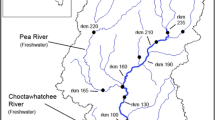Abstract
The present study evaluates the variations of 137Ba abundance in pectoral fin spine of 1-month-old juvenile Persian sturgeon (Acipenser persicus) upon marking using the stable isotope approach. The marking of the fish was achieved by incorporation of 137Ba2+ in the calcified lattice of the pectoral fin spine through substitution with structural Ca2+. This process was carried out by rearing juveniles in treatment tanks containing elevated concentrations of 137Ba for 1, 3 and 5 days. The marked fish were then retained in natural abundance fresh and brackish waters, to evaluate the trend of exchange of 137Ba from the fin spines. The abundance of 137Ba in fin spines during marking and post-marking experiments were detected by inductively coupled plasma mass spectrometry (ICP-MS). The results showed that a significant isotope mark can be obtained with no mortality and 100% marking rate on the first day of exposure to the isotope. The marked juveniles maintained their isotopic signature for at least 25 days. Statistical analysis of the obtained 138Ba/137Ba ratios demonstrated that the successful incorporation of 137Ba2+ in pectoral fin spines provides an effective marking method for Persian sturgeon restocking programs.



Similar content being viewed by others
References
Allen PJ, Hobbs JA, Cech JJ Jr, Van Eenennaam JP, Doroshov SI (2009) Using trace elements in pectoral fin rays to assess life history movements in sturgeon: estimating age at initial seawater entry in Klamath River green sturgeon. Trans Am Fish Soc 138:240–250
Bath GE, Thorrold SR, Jones CM, Campana SE, McLaren JW, Lam JW (2000) Strontium and barium uptake in aragonitic otoliths of marine fish. Geochimica Cosmochimica Acta 64:1705–1714
Butcher A, Mayer D, Willett D, Johnston M, Smallwood D (2003) Scale pattern analysis is preferable to OTC marking of otoliths for differentiating between stocked and wild dusky flathead, Platycephalus fuscus, and sand whiting, Sillago ciliata. Fish Manag Ecol 10:163–172
Clarke A, Telmer K, Mark Shrimpton J (2007) Elemental analysis of otoliths, fin rays and scales: a comparison of bony structures to provide population and life-history information for the Arctic grayling (Thymallus arcticus). Ecol Freshw Fish 16:354–361
Dabrowski K, Tsukamoto K (1986) Tetracycline tagging in coregonid embryos and larvae. J Fish Biol 29:691–698
Findeis EK (1997) Osteology and phylogenetic interrelationships of sturgeons (Acipenseridae). Environ Biol Fishes 48:73–126
Gharrett A, Lane S, McGregor A, Taylor S (2001) Use of a genetic marker to examine genetic interaction among subpopulations of pink salmon (Oncorhynchus gorbuscha). Genetica 111:259–267
Gillanders BM (2009) Tools for studying biological marine ecosystem interactions—natural and artificial tags. In: Ecological Connectivity among Tropical Coastal Ecosystems. Springer, 457–492
Huelga-Suarez G, Moldovan M, Garcia-Valiente A, Garcia-Vazquez E, Alonso JIG (2011) Individual-specific transgenerational marking of fish populations based on a barium dual-isotope procedure. Anal Chem 84:127–133
Huelga-Suarez G, Fernández B, Moldovan M, Alonso JIG (2013) Detection of transgenerational barium dual-isotope marks in salmon otoliths by means of LA-ICP-MS. Anal Bioanal Chem 405:2901–2909
Lo-Yat A, Meekan M, Munksgaard N, Parry D, Planes S, Wolter M, Carleton J (2005) Small-scale spatial variation in the elemental composition of otoliths of Stegastes nigricans (Pomacentridae) in French Polynesia. Coral Reefs 24:646–653
Munro AR, Gillanders BM, Elsdon TS, Crook DA, Sanger AC (2008) Enriched stable isotope marking of juvenile golden perch (Macquaria ambigua) otoliths. Can J Fish Aquat Sci 65:276–285
Munro A, Gillanders B, Thurstan S, Crook D, Sanger A (2009) Transgenerational marking of freshwater fishes with enriched stable isotopes: a tool for fisheries management and research. J Fish Biol 75:668–684
Reinert TR, Wallin J, Griffin MC, Conroy MJ, Van Den Avyle MJ (1998) Long-term retention and detection of oxytetracycline marks applied to hatchery-reared larval striped bass, Morone saxatilis. Can J Fish Aquat Sci 55:539–543
Rossiter A, Noakes DLG, Beamish FWH (1995) Validation of age estimation for the lake sturgeon. Trans Am Fish Soc 124:777–781
Smith K, Whitledge G (2011) Evaluation of a stable-isotope labelling technique for mass marking fin rays of age-0 lake sturgeon. Fish Manag Ecol 18:168–175
Thomas L, Holt S, Arnold C (1995) Chemical marking techniques for larval and juvenile red drum (Sciaenops ocellatus) otoliths using different fluorescent markers. Recent developments in fish otolith research (University of South Carolina Press, USA, 1995). 703–717
Thorrold SR, Jones GP, Planes S, Hare JA (2006) Transgenerational marking of embryonic otoliths in marine fishes using barium stable isotopes. Can J Fish Aquat Sci 63:1193–1197
van der Walt B, Faragher RA (2003) Otolith marking of rainbow trout fry by immersion in low concentrations of alizarin complexone. N Am J Fish Manag 23:141–148
Warren-Myers F, Dempster T, Fjelldal PG, Hansen T, Jensen AJ, Swearer SE (2014) Stable isotope marking of otoliths during vaccination: a novel method for mass-marking fish. Aquac Environ Interact 5:143
Williamson D, Jones G, Thorrold SR, Frisch AJ (2009) Transgenerational marking of marine fish larvae: stable-isotope retention, physiological effects and health issues. J Fish Biol 74:891–905
Woodcock S, Gillanders B, Munro A, McGovern F, Crook D, Sanger A (2011a) Using enriched stable isotopes of barium and magnesium to batch mark otoliths of larval golden perch (Macquaria ambigua, Richardson). Ecol Freshw Fish 20:157–165
Woodcock SH, Gillanders BM, Munro AR, Crook DA, Sanger AC (2011b) Determining mark success of 15 combinations of enriched stable isotopes for the batch marking of larval otoliths. N Am J Fish Manag 31:843–851
Acknowledgements
The authors are grateful to the biochemistry laboratory staff of Guilan University for their collaboration. We also thank Mr. Mir-Ghasem NaserAlavi and Dr. Shahram Abdolmaleki for their helpful comments on this research and Mr. Masud Alizadeh, for assistance in fieldwork. This project was supported by the Shahid Beheshti Sturgeon Hatchery and the University of Guilan.
Author information
Authors and Affiliations
Corresponding author
Rights and permissions
About this article
Cite this article
Mirali, H., Bani, A. & Fasihi, J. Application of enriched 137Ba tracer to mark juvenile Persian sturgeon (Acipenser persicus). Environ Biol Fish 100, 163–169 (2017). https://doi.org/10.1007/s10641-016-0560-3
Received:
Accepted:
Published:
Issue Date:
DOI: https://doi.org/10.1007/s10641-016-0560-3




